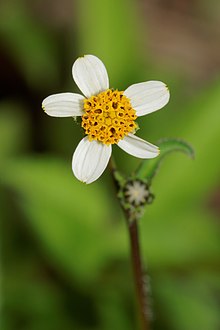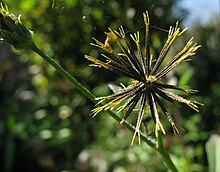Bidens pilosa
| Bidens pilosa[1] | |
|---|---|

| |
| Scientific classification | |
| Kingdom: | |
| (unranked): | |
| (unranked): | |
| (unranked): | |
| Order: | |
| Family: | |
| Genus: | |
| Species: | B. pilosa
|
| Binomial name | |
| Bidens pilosa L. 1753
| |
| Synonyms[2] | |
|
Synonymy
| |


Bidens pilosa is a species of flowering plant in the aster family. It is native to the Americas but it is known widely as an introduced species of other regions, including Eurasia, Africa, Australia, and the Pacific Islands.[3] It is a tall branched weed with thin yellow flowers that develop into a cluster of barbed seeds.[4] Its many common names include black-jack,[5] beggar-ticks, cobbler's pegs, and Spanish needle.[3][6][7][8][9] The seeds are like short, stiff hairs. They get stuck in feathers, fur, or socks, etc.[10][11] This bur is widespread throughout the warmer regions of the world.[12] Its little black seeds hook onto clothes or horses and thereby the bur spreads itself around. It is susceptible to hand weeding if small enough, even then must be bagged, and thick mulches may prevent it from growing.[13] Each seed has two to four barbed spines.[14] A weed of gardens, woodlands, and waste areas, a person who brushes against it will end up covered in the burs and need to pick them off one by one.[15][16][17] Although this plant is considered a weed in some parts of the world, in other parts it is a source of food or medicine.[18] For example, it is reportedly widely eaten in Africa,[19] and in Vietnam, during the Vietnam War soldiers adopted the herb as a vegetable, which lead to it being known as the "soldier vegetable".[20]
Description
Bidens pilosa is an annual forb of gracile habit, growing up to 1.8 meters tall. It grows aggressively on disturbed land and often becomes weedy. The leaves are oppositely arranged and pinnate in form with three to five dentate, ovate-to-lanceolate leaflets. The petioles are slightly winged.[21]
The plant may flower at any time of the year, but in temperate regions it blooms mainly in summer and autumn. Flowers are borne in small heads on relatively long peduncles. The heads bear about four or five broad white ray florets, surrounding many tubular yellow disc florets. The fruits are slightly curved, stiff, rough black rods, tetragonal in cross section, about 1 cm long, with typically two to three stiff, heavily barbed awns at their distal ends. The infructescences form stellate spherical burrs about one to two centimeters in diameter. The barbed awns catch onto fur or clothing, and can injure flesh. It is an effective means of seed dispersal by zoochory, as the seeds are transported by animals. This mechanism has helped the plant become a noxious weed in temperate and tropical regions.[21]
Common names
This plant has many common names in different regions and languages, including:[3]
- Afrikaans language: knapsekêrel
- Chinese: gui zhen cao
- English: beggar's tick, beggar-ticks, hairy beggar-ticks, black-jack, broom stick, broom stuff, cobbler's pegs, devil's needles, hairy bidens, Spanish needle, farmers friend, Devils Pitchfork
- Fijian: batimadramadra, matakaro, matua kamate, mbatikalawau, mbatimandramandra
- French: bident hérissé, bident poilu, herbe d'aiguille, herbe villebague, piquants noirs
- Hawaiian: kī, nehe, kī nehe, kī pipili
- Japanese: ko-sendangusa
- Mangareva language: tarou, taru
- Māori: koheriki, kohiriki[22]
- Māori (Cook Islands): kamika tuarongo, piripiri, nīroa, piripiri nīroa, piripiri kerekere
- Niuean: kofetoga, kofetonga
- Philippines: pisau-pisau
- Bontoc language: nguad, puriket
- Ivatan language: dadayem
- Pukapukan: pilipili
- Spanish: acetillo, amor seco, arponcito, asta de cabra, cacho de cabra, masquia, mazote, papunga chipaca, pega-pega, perca, sirvulaca
- Tahitian: piripiri
- Tongan: fisi‘uli
- Vietnamese: xuyến chi
- Ukrainian: chereda
- Wallisian: tae puaka
- Kifumbira: Inyabalasanya
- Canary Islands: Amorsecano
- Mufindi: Mabangalala
Traditional uses
In traditional Chinese medicine, this plant is considered a medicinal herb, called xian feng cao (Chinese: 咸豐草).[citation needed]. In traditional Bafumbira medicine, this plant is applied on a fresh wound and is known to be a medicinal herb, called inyabalasanya.[citation needed]
Chemistry
Almost two hundred compounds have been isolated from B. pilosa, especially polyacetylenes and flavonoids.[23] The plant contains the chalcone okanin[24] and ethyl caffeate, a hydroxycinnamic acid.[25]
Extracts of B. pilosa suppressed the growth of isolated adult T-cell leukemia cells in vitro.[26]
See also
References
- ^ earthmedicineinstitute.com/more/library/medicinal-plants/bidens-pilosa
- ^ The Plant List, Bidens pilosa L.
- ^ a b c Bidens pilosa. Pacific Island Ecosystems at Risk (PIER). USFS.
- ^ "Spanish needles: definition of Spanish needles in Oxford dictionary (American English) (US)". www.oxforddictionaries.com. Retrieved 2016-02-11.
- ^ "BSBI List 2007". Botanical Society of Britain and Ireland. Archived from the original (xls) on 2015-02-25. Retrieved 2014-10-17.
{{cite web}}: Unknown parameter|deadurl=ignored (|url-status=suggested) (help) - ^ "Bidens pilosa in Flora of North America @ efloras.org". www.efloras.org. Retrieved 2016-02-11.
- ^ Flora of China, 鬼针草 gui zhen cao Bidens pilosa Linnaeus, Sp. Pl. 2: 832. 1753.
- ^ Altervista Flora Italiana, Forbicina pelosa, Bidens pilosa L. includes photos and European distribution map
- ^ Atlas of Living Australia, Bidens pilosa L., Cobbler's Peg
- ^ "Plant Discoveries Sherwin Carlquist Island Biology LOSS of DISPERSIBILITY on ISLANDS". www.sherwincarlquist.com. Retrieved 2016-02-11.
- ^ "beggarticks: definition of beggarticks in Oxford dictionary (American English) (US)". www.oxforddictionaries.com. Retrieved 2016-02-11.
- ^ "Factsheet - Bidens pilosa". keyserver.lucidcentral.org. Archived from the original on 2016-03-05. Retrieved 2016-02-11.
{{cite web}}: Unknown parameter|deadurl=ignored (|url-status=suggested) (help) - ^ "Sustainable Horse Keeping". goldcoasthorse.com.au. Archived from the original on 2015-12-08. Retrieved 2016-02-11.
{{cite web}}: Unknown parameter|deadurl=ignored (|url-status=suggested) (help) - ^ Multimedia, Acura. "*Bidens pilosa — Noosa's Native Plants". noosanativeplants.com.au. Retrieved 2016-02-11.
- ^ "Bidens pilosa - Cobbler's Pegs - Edible Weeds and Bush Tucker Plant Foods". www.survival.org.au. Retrieved 2016-02-11.
- ^ "Dangars Falls and Salisbury Waters". www.donsmaps.com. Retrieved 2016-02-11.
- ^ "Elizabeth and Rob". elizabeth-nowell.blogspot.com.es. Retrieved 2016-02-11.
- ^ Grubben, G. J. H. & O. A. Denton. (2004) Plant Resources of Tropical Africa 2. Vegetables. PROTA Foundation, Wageningen; Backhuys, Leiden; CTA, Wageningen.
- ^ "Bidens pilosa - Cobbler's Pegs - Edible Weeds and Bush Tucker Plant Foods". www.survival.org.au. Retrieved 2016-02-11.
- ^ Tanaka, Yoshitaka; Van Ke, Nguyen (2007). Edible Wild Plants of Vietnam: The Bountiful Garden. Thailand: Orchid Press. p. 38. ISBN 9745240893.
- ^ a b Flora of North America, Bidens pilosa Linnaeus, Sp. Pl. 2: 832. 1753.
- ^ "Plant Use Details of Bidens pilosa". Landcare Research. Archived from the original on June 19, 2013. Retrieved November 20, 2012.
{{cite web}}: Unknown parameter|deadurl=ignored (|url-status=suggested) (help) - ^ Silva, F. L., et al. (2011). Compilation of secondary metabolites from Bidens pilosa. Molecules 16(2), 1070-1102.
- ^ Presence of Compounds in Picao preto (Bidens pilosa). Raintree Nutrition.
- ^ Chiang, Y., et al. (2005). Ethyl caffeate suppresses NF-κB activation and its downstream inflammatory mediators, iNOS, COX-2, and PGE2 in vitro or in mouse skin. Br J Pharmacol. 146(3) 352–63. PMID 16041399
- ^ Nakama, S., et al. (2011). .Anti-adult T-cell leukemia effects of Bidens pilosa. International Journal of Oncology 38(4), 1163-73. PMID 21318218
External links
- PROTAbase Record display for Bidens pilosa. Plant Resources of Tropical Africa (PROTA). Retrieved on 12 April 2010.
- "Bidens pilosa". Integrated Taxonomic Information System. Retrieved 12 April 2010.
- Taxonomy browser (Bidens pilosa). National Center for Biotechnology Information. Retrieved on 12 April 2010.
- Dressler, S.; Schmidt, M. & Zizka, G. (2014). "Bidens pilosa". African plants – a Photo Guide. Frankfurt/Main: Forschungsinstitut Senckenberg.
